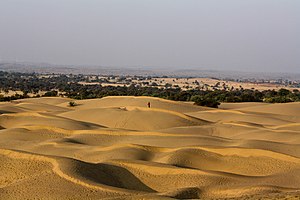ทะเลทรายธาร์
ทะเลทรายธาร์ (ฮินดี: थर मरुस्थल; อูรดู: صحرائے تھار; อังกฤษ: Thar Desert) หรือเรียกอีกชื่อว่า ทะเลทรายอินเดียใหญ่ (อังกฤษ: Great Indian Desert) เป็นทะเลทรายขนาดใหญ่ ตั้งอยู่ทางตะวันตกเฉียงเหนือของประเทศอินเดียและปากีสถาน มีพื้นที่มากกว่า 200,000 ตร.กม. (77,000 ตร.ไมล์)[3] ถือเป็นพื้นที่แห้งแล้งที่ใหญ่เป็นอันดับ 9 ของโลก[4]
| ทะเลทรายธาร์ ทะเลทรายอินเดียใหญ่ | |
|---|---|
 ทะเลทรายในรัฐราชสถาน ประเทศอินเดีย | |
 แผนที่เขตภูมินิเวศทะเลทรายธาร์ | |
| นิเวศวิทยา | |
| ดินแดน | อินโดมาลายา |
| ชีวนิเวศ | ทะเลทรายและไม้พุ่มแห้งแล้ง |
| พรมแดน | ป่าชัฏดงดิบตะวันตกเฉียงเหนือ และ บ่อเกลือตามฤดูกาลรันน์แห่งคุตช์ |
| ภูมิศาสตร์ | |
| พื้นที่ | 238,254 km2 (91,990 sq mi) |
| ประเทศ | อินเดีย และ ปากีสถาน |
| รัฐของอินเดียและแคว้นของปากีสถาน | ราชสถาน, คุชราต, หรยาณา, ปัญจาบ (อินเดีย), ปัญจาบ และ สินธ์ (ปากีสถาน) |
| พิกัด | 27°N 71°E / 27°N 71°E |
| Conservation | |
| สถานะการอนุรักษ์ | มีความเสี่ยง[1] |
| การป้องกัน | 41,833 ตร.กม. (18%)[2] |
ประมาณร้อยละ 85 ของทะเลทรายธาร์อยู่ในอินเดีย และประมาณร้อยละ 15 อยู่ในปากีสถาน[5] ทะเลทรายธาร์กินพื้นที่ทางภูมิศาสตร์ของอินเดียรวมประมาณร้อยละ 4.56 ทะเลทรายมากกว่าร้อยละ 60 ตั้งอยู่ในรัฐราชสถาน ส่วนที่เหลือกระจายไปในรัฐคุชราต, รัฐปัญจาบ และรัฐหรยาณา และส่วนที่กระจายในปากีสถานอยู่ในแคว้นสินธ์[6] และแคว้นปัญจาบ (ส่วนทะเลทรายในแคว้นหลังถูกเรียกเป็นทะเลทรายโชลิสถาน)
ทะเลทรายล้อมรอบด้วยทิวเขาอะราวัลลีทางด้านตะวันออก แม่น้ำคงคาทางด้านตะวันตก แม่น้ำสัตเลชทางด้านเหนือ และทะเลอาหรับทางด้านใต้
อ้างอิง แก้
- ↑ "Thar Desert". Terrestrial Ecoregions. World Wildlife Fund.
- ↑ Eric Dinerstein, David Olson, et al. (2017). An Ecoregion-Based Approach to Protecting Half the Terrestrial Realm, BioScience, Volume 67, Issue 6, June 2017, Pages 534–545; Supplemental material 2 table S1b. [1]
- ↑ Sahara Desert - Britannica Online Encyclopedia
- ↑ Dr Mohan La Gupta: Rajasthan Jyankosh, Jojo Granthagar, Jodhpur, 2008, ISBN 81-86103-05-8, p.69
- ↑ Sinha, R. K., Bhatia, S., & Vishnoi, R. (1996). "Desertification control and rangeland management in the Thar desert of India". RALA Report No. 200: 115–123.
- ↑ Sharma, K. K. and S. P. Mehra (2009). "The Thar of Rajasthan (India): Ecology and Conservation of a Desert Ecosystem". Chapter 1 in: Sivaperuman, C., Baqri, Q. H., Ramaswamy, G., & Naseema, M. (eds.) Faunal ecology and conservation of the Great Indian Desert. Springer, Berlin Heidelberg.
อ่านเพิ่ม แก้
- Bhandari M. M. Flora of The Indian Desert, MPS Repros, 39, BGKT Extension, New Pali Road, Jodhpur, India.
- Zaigham, N. A. (2003). "Strategic sustainable development of groundwater in Thar Desert of Pakistan". Water Resources in the South: Present Scenario and Future Prospects, Commission on Science and Technology for Sustainable Development in the South, Islamabad.
- Govt. of India. Ministry of Food & Agriculture booklet (1965)—"Soil conservation in the Rajasthan Desert"—Work of the Desert Afforestation Research station, Jodhpur.
- Gupta, R. K. & Prakash Ishwar (1975). Environmental analysis of the Thar Desert. English Book Depot., Dehra Dun.
- Kaul, R. N. (1967). "Trees or grass lands in the Rajasthan: Old problems and New approaches". Indian Forester, 93: 434–435.
- Burdak, L. R. (1982). "Recent Advances in Desert Afforestation". Dissertation submitted to Shri R. N. Kaul, Director, Forestry Research, F.R.I., Dehra Dun.
- Yashpal, Sahai Baldev, Sood, R.K., and Agarwal, D.P. (1980). "Remote sensing of the 'lost' Saraswati river". Proceedings of the Indian Academy of Sciences (Earth and Planet Science), V. 89, No. 3, pp. 317–331.
- Bakliwal, P. C. and Sharma, S. B. (1980). "On the migration of the river Yamuna". Journal of the Geological Society of India, Vol. 21, Sept. 1980, pp. 461–463.
- Bakliwal, P. C. and Grover, A. K. (1988). "Signature and migration of Sarasvati river in Thar desert, Western India". Record of the Geological Survey of India V 116, Pts. 3–8, pp. 77–86.
- Rajawat, A. S., Sastry, C. V. S. and Narain, A. (1999-a). "Application of pyramidal processing on high resolution IRS-1C data for tracing the migration of the Saraswati river in parts of the Thar desert". in "Vedic Sarasvati, Evolutionary History of a Lost River of Northwestern India", Memoir Geological Society of India, Bangalore, No. 42, pp. 259–272.
- Ramasamy, S. M. (1999). "Neotectonic controls on the migration of Sarasvati river of the Great Indian desert". in "Vedic Sarasvati, Evolutionary History of a Lost River of Northwestern India", Memoir Geological Society of India, Bangalore, No. 42, pp. 153–162.
- Rajesh Kumar, M., Rajawat, A. S. and Singh, T. N. (2005). "Applications of remote sensing for educidate the Palaeochannels in an extended Thar desert, Western Rajasthan", 8th annual International conference, Map India 2005, New Delhi.
แหล่งข้อมูลอื่น แก้
- คู่มือการท่องเที่ยว ทะเลทรายธาร์ จากวิกิท่องเที่ยว (ในภาษาอังกฤษ)
- Rajasthan Tourism
- "Thar Desert". Terrestrial Ecoregions. World Wildlife Fund.
- Dharssi.org.uk, Photos of the Thar Desert
- Avgustin.net, Photos of the Thar Desert in Pakistan side
- MIT.gov[ลิงก์เสีย], आपणो राजस्थान


